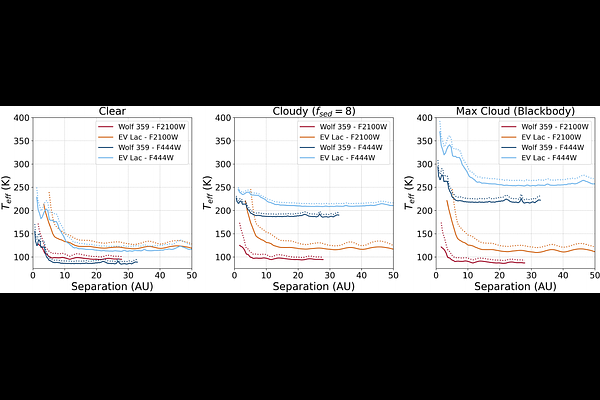NIRCam yells at cloud: JWST MIRI imaging can directly detect exoplanets of the same temperature, mass, age, and orbital separation as Saturn and Jupiter

NIRCam yells at cloud: JWST MIRI imaging can directly detect exoplanets of the same temperature, mass, age, and orbital separation as Saturn and Jupiter
Rachel Bowens-Rubin, James Mang, Mary Anne Limbach, Aarynn L. Carter, Kevin B. Stevenson, Kevin Wagner, Giovanni Strampelli, Caroline V. Morley, Grant Kennedy, Elisabeth Matthews, Andrew Vanderburg, Maïssa Salama
AbstractNIRCam and MIRI coronagraphy have successfully demonstrated the ability to directly image young sub-Jupiter mass and mature gas-giant exoplanets. However, these modes struggle to reach the sensitivities needed to find the population of cold giant planets that are similar to our own Solar System's giant planets ($T_{\rm eff} = 60 - 125$ K; $a=5 - 30$ AU). For the first time, we explore the high-contrast imaging capabilities of MIRI imaging rather than coronagraphy. Using data from the JWST GO 6122: Cool Kids on the Block program which targets nearby ($<6$ pc) M-dwarfs with NIRCam coronagraphy and MIRI imaging, we demonstrate that 21$\mu$m MIRI imaging can detect planets with the same temperature, mass, age, and orbital separations as Saturn and Jupiter. For systems within 3pc, 21$\mu$m MIRI imaging reaches the sensitivity needed to detect planets colder than Saturn ($<95$ K). NIRCam coronagraphy can achieve similar results only in the unlikely case that a cold giant planet is cloud-free. Motivated by these compelling findings, we extend our analysis to evaluate the measured performance of MIRI F2100W imaging versus NIRCam F444W coronagraphy to 70 pc and conclude that MIRI imaging offers the advantage for systems within 20pc. Microlensing surveys predict an occurrence rate as high as 1 - 2 low-mass giant exoplanets per star, suggesting that JWST MIRI imaging surveys of nearby systems may be poised to uncover a substantial population. This breakthrough enables a path towards the first direct characterization of cold giant exoplanets that are analogous to the solar system giant planets.